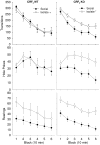CRF2 null mutation increases sensitivity to isolation rearing effects on locomotor activity in mice
- PMID: 20466421
- PMCID: PMC2888500
- DOI: 10.1016/j.npep.2010.04.005
CRF2 null mutation increases sensitivity to isolation rearing effects on locomotor activity in mice
Abstract
Background: Developmental stressors are consistently reported to increase risk for certain neuropsychiatric disorders including schizophrenia, depression, and post-traumatic stress disorder. Recent clinical evidence supports a "double-hit" hypothesis of genetic vulnerability interacting with developmental challenges to modulate this risk. Early life stressor effects on behavior may be modulated in part by alterations in corticotropin releasing factor (CRF) signaling via two known receptors, CRF(1) and CRF(2). One extant hypothesis is that CRF(2) activation may modulate long-term adaptive responses after homeostatic challenge. As such, loss of CRF(2) activity via genetic variance may increase sensitivity to the long-term effects of developmental stress.
Methods: We tested the hypothesis that CRF(2) function may mitigate the behavioral effects of isolation rearing, predicting that loss of CRF(2) function increases sensitivity to this developmental challenge. Using the behavioral pattern monitor (BPM), we examined exploratory behavior and locomotor patterns in adult CRF(2) wild-type (WT) and gene knockout (KO) mice reared socially or in isolation.
Results: Isolation housing produced robust increases in the amount of locomotor activity and investigatory holepoking, and altered the temporal distribution of activity in CRF(2) KO but not CRF(2) WT mice. Isolation housing significantly increased rearing behavior and altered spatial patterns of locomotor activity regardless of genotype.
Conclusions: Loss of CRF(2) function increased sensitivity to the effects of chronic social isolation on exploratory locomotor behavior. Thus, CRF(2) activation appears to mitigate isolation rearing effects on exploratory behavior. Further research assessing the interaction between CRF(2) function and developmental challenges is warranted.
Published by Elsevier Ltd.
Conflict of interest statement
All other authors have no conflicts to disclose.
Figures


Similar articles
-
Isolation rearing-induced deficits in contextual fear learning do not require CRF(2) receptors.Behav Brain Res. 2010 May 1;209(1):80-4. doi: 10.1016/j.bbr.2010.01.018. Epub 2010 Jan 25. Behav Brain Res. 2010. PMID: 20097235 Free PMC article.
-
CRF1 and CRF2 receptors are required for potentiated startle to contextual but not discrete cues.Neuropsychopharmacology. 2009 May;34(6):1494-503. doi: 10.1038/npp.2008.205. Epub 2008 Nov 19. Neuropsychopharmacology. 2009. PMID: 19020499 Free PMC article.
-
Dissection of corticotropin-releasing factor system involvement in locomotor sensitivity to methamphetamine.Genes Brain Behav. 2011 Feb;10(1):78-89. doi: 10.1111/j.1601-183X.2010.00641.x. Epub 2010 Sep 30. Genes Brain Behav. 2011. PMID: 20731720 Free PMC article.
-
Don't stress about CRF: assessing the translational failures of CRF1antagonists.Psychopharmacology (Berl). 2017 May;234(9-10):1467-1481. doi: 10.1007/s00213-017-4556-2. Epub 2017 Mar 7. Psychopharmacology (Berl). 2017. PMID: 28265716 Free PMC article. Review.
-
Effect of early life social adversity on drug abuse vulnerability: Focus on corticotropin-releasing factor and oxytocin.Neuropharmacology. 2021 Jun 15;191:108567. doi: 10.1016/j.neuropharm.2021.108567. Epub 2021 Apr 13. Neuropharmacology. 2021. PMID: 33862030 Free PMC article. Review.
Cited by
-
Sweet success, bitter defeat: a taste phenotype predicts social status in selectively bred rats.PLoS One. 2012;7(10):e46606. doi: 10.1371/journal.pone.0046606. Epub 2012 Oct 3. PLoS One. 2012. PMID: 23056367 Free PMC article.
-
Behavioral Studies and Genetic Alterations in Corticotropin-Releasing Hormone (CRH) Neurocircuitry: Insights into Human Psychiatric Disorders.Behav Sci (Basel). 2012 Jun 21;2(2):135-71. doi: 10.3390/bs2020135. Behav Sci (Basel). 2012. PMID: 23077729 Free PMC article.
-
Anxiety states induced by post-weaning social isolation are mediated by CRF receptors in the dorsal raphe nucleus.Brain Res Bull. 2011 May 30;85(3-4):117-22. doi: 10.1016/j.brainresbull.2011.03.003. Epub 2011 Mar 9. Brain Res Bull. 2011. PMID: 21396988 Free PMC article.
-
The CRF system and social behavior: a review.Front Neurosci. 2013 May 31;7:92. doi: 10.3389/fnins.2013.00092. eCollection 2013. Front Neurosci. 2013. PMID: 23754975 Free PMC article.
References
-
- Bale TL, Vale WW. CRF and CRF receptors: role in stress responsivity and other behaviors. Annu Rev Pharmacol Toxicol. 2004;44:525–57. - PubMed
-
- Binder EB, Bradley RG, Liu W, Epstein MP, Deveau TC, Mercer KB, Tang Y, Gillespie CF, Heim CM, Nemeroff CB, Schwartz AC, Cubells JF, Ressler KJ. Association of FKBP5 polymorphisms and childhood abuse with risk of posttraumatic stress disorder symptoms in adults. JAMA. 2008;299:1291–1305. - PMC - PubMed
-
- Bradley RG, Binder EB, Epstein MP, Tang Y, Nair HP, Liu W, Gillespie CF, Berg T, Evces M, Newport DJ, Stowe ZN, Heim CM, Nemeroff CB, Schwartz A, Cubells JF, Ressler KJ. Influence of child abuse on adult depression: Moderation by the corticotropin-releasing hormone receptor gene. Arch Gen Psychiatry. 2008;65:190–200. - PMC - PubMed
-
- Coste SC, Heard AD, Phillips TJ, Stenzel-Poore MP. Corticotropin-releasing factor receptor type 2-deficient mice display impaired coping behaviors during stress. Genes Brain Behav. 2006;5:131–138. - PubMed
-
- Coste SC, Kesterson RA, Heldwein KA, Stevens SL, Heard AD, Hollis JH, Murray SE, Hill JK, Pantely GA, Hohimer AR, Hatton DC, Phillips TJ, Finn DA, Low MJ, Rittenberg MB, Stenzel-Poore MP. Abnormal adaptations to stress and impaired cardiovascular function in mice lacking corticotropin-releasing hormone receptor-2. Nat Genet. 2000;24:403–409. - PubMed
Publication types
MeSH terms
Substances
Grants and funding
LinkOut - more resources
Full Text Sources
Research Materials

